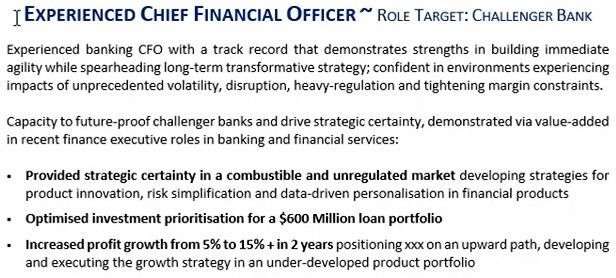Are you one of those people who’s struggling to write your career objective – and end up putting in buzz words on your LinkedIn profile or resume that do not really reflect you?
Is that because you think that’s what you’re supposed to do?
If you write things like you’re a dynamic, team player with 10 years’ experience, you’re actually wasting valuable space on the top section of your resume (and your LinkedIn profile).
A thoughtful and sincere career objective – matched up to the role you want to do, can sell you by itself – without the rest of your resume needing to do as much work.
So let’s banish boring today with my 4-step formula for writing a powerful career objective.
Plus to really make it clear for you, I’m going to give you some real-life examples from my clients.
These are examples that have helped them stand out and win interviews.
I want to talk about, what a career objective is, and what a career objective isn’t.
Because I think there’s a lot of confusion that you might see online or other sources.
What is a Career Objective?
A career objective is not all about you.
It is about the value that you can deliver to an employer – with your strengths, skills, and way of working.
A career objective doesn’t have to be bland. You can actually inject a lot of your personality into it!
And a well-written career objective can illustrate some proof points of what you can bring to the role.
The way I use a career objective in the resumes that I develop for my clients is for the recruiter to see at a glance:
- what it is that you know
- what’s the job you’re applying for
- why you’re applying for the job
- and the value that you can bring to that job, with your strengths, skills, and experience
Now, let’s dive into my 4-point formula.
4-Step Formula to Write a Career Objective
This is the same formula that I’ve used time and time again with my clients.
To create a really powerful career objective for a resume:

Step 1: Outline your target role
Write in your objective what your target role is.
Step 2: Describe the skills and experience you can bring to your target role
Think about what you can bring to that role specifically with the skills, knowledge, or experience that you have.
Step 3: Describe the value you can add to your target role
This is how you can actually add value to your target role – how your skills will benefit your target employer.
Step 4: Provide proof points you can add value
This is the demonstration that you can deliver some value to the role and employer.
Each career objective should be written specifically for the role that you’re going to apply for.
They’re not generic.
They should be tailored for a specific role.
And it’s an important first step to get right on your resume!

Now that you know the formula, I will show you some great resume objective examples.
Real-Life Career Objective Examples
Here are some examples of career objectives where you can see how to pull it all together.
Career Objective Example: Chief Financial Officer

So, to break it down into the 4-step formula:
Step 1: Target role
Experienced Chief Financial Officer ~ Role Target: Challenger Bank
Step 2: Describe the skills

Step 3: Describe the value you can add
Capacity to future-proof challenger banks and drive strategic certainty
Step 4: Provide proof points of your ability to deliver

You can see how all that fits neatly together in a career objective.
That pretty much sells him for the role that he’s aiming for.
And it’s written all around the target role.
Career Objective Example: Marketing Manager
For the second example, let’s have a look at the resume career objective of a client who is a Marketing Manager:

And here’s the breakdown:
Step 1: Target role
MARKETING MANAGER
CUSTOMER ACQUISITION MANAGER
Step 2: Describe the skills
My customers all say I’m packed full of energy – always exceeding marketing goals applying curiosity, creativity, and passion.
Step 3: Describe the value
I’m seeking opportunities to apply these skills in start-ups keen to increase their customer base.
Step 4: Provide proof points
- Doubled membership and tripled revenue
- Created $2 Million in sales leads
- Increased advertising sales profit from -$20,000 to +$40,000
- Amplified reach and engagement across new digital channels
So, the career objective encapsulates all four points and sits succinctly at the top of a resume.
It has the wow factor.
And it frames up the way that a recruiter will read that resume.
So that’s my four-step formula and a couple of examples that I hope you’ll be able to apply for yourself.
If you want to know how to fit career objectives into a resume, I suggest you read my blog on Career Change Resume here.
And if you’d like to see free samples of career change resumes, you may get it here!
You might also want to check out the video I’ve made about career objectives:

 Follow
Follow

{ 0 comments… add one now }